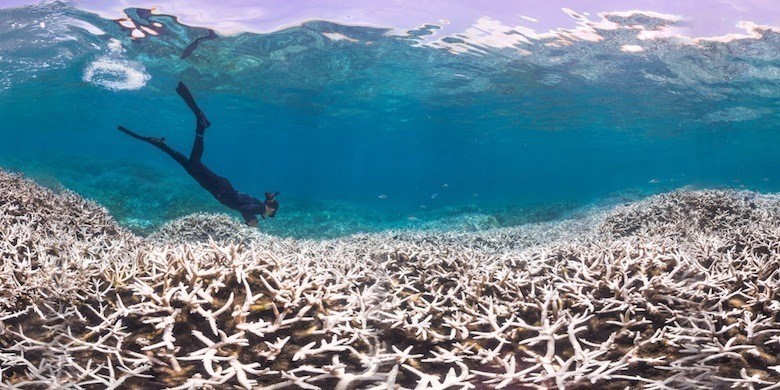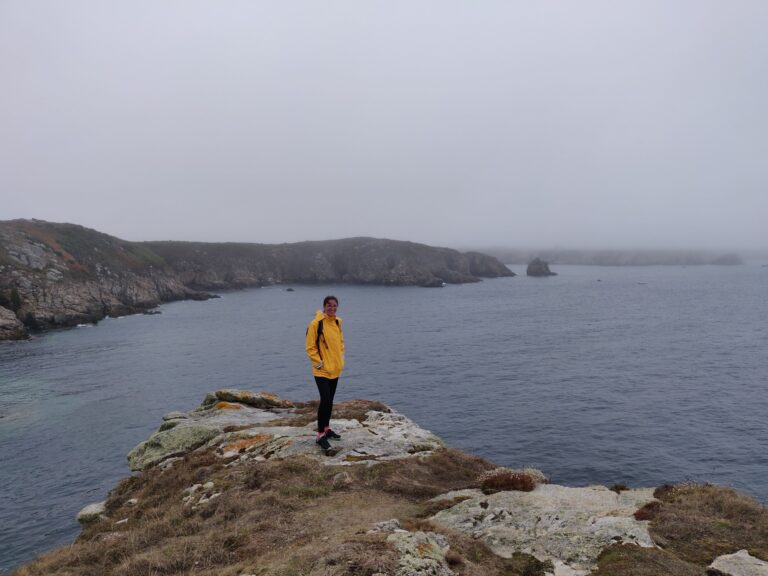Climate change as experienced by corals


Reef bleaching / Photography at the discretion of XL Catlin Seaview Survey
Coral reefs are home to a remarkable biodiversity and are under pressure as we enter the Anthropocene era (the era of man). Between pollution, ocean acidification and global warming, the fragile balance between the species inhabiting the vast ecosystem of which they are the cement is being upset.
1 The causes of a deteriorating state of health
A study conducted by Lauretta Burke in 2011 highlighted the threats affecting coral reefs. Overfishing, destructive fishing techniques, coastal development and pollution are all having a major impact on marine ecosystems.

Figure 1: Percentage of danger to coral reefs by risk category. (UNEP Report – “Reefs at risk revisited. (2011). Management of Environmental Quality: An International Journal, 22(4).
Threats to coral reefs have increased globally by 30% in ten years, with an increase observed in all hazard categories. As shown in Figure 1, 75% of corals were threatened by human activities and climate change in 2011.
2. The impact of global warming
In 2016, there was an unprecedented loss of coral as a result of massive bleaching in the Great Barrier Reef in Australia. Indeed, more than 50% of the coral cover was lost in 8 months on the northern part of the Great Barrier Reef. In their study published in April 2018 in the journal Nature, Terry P. Hughes and his team sought to establish a correlation between heat waves, bleaching and coral death. A clear overlay of maps can be seen in Figure 2, one showing regions impacted by coral death and the other showing rising temperatures in those regions. There is thus a link between the loss of coral cover and the increase in ocean temperature. Indeed, the initial mortality rate increases gradually with increasing heat exposure; about 5% of corals died on reefs exposed to heat accumulation of less than 4°C-week, while an average of 15.6% was recorded on reefs exposed to temperature anomalies of 4 to 8°C-week.

Figure 2: Large-scale spatial profiles of changes in coral cover (a) and heat exposure (b) on the Great Barrier Reef, Australia. (Hughes, T., Kerry, J., Baird, A., Connolly, S., Dietzel, A., Eakin, C., Heron, S., Hoey, A., Hoogenboom, M., Liu, G., McWilliam, M., Pears, R., Pratchett, M., Skirving, W., Stella, J. and Torda, G. (2018). Global warming transforms coral reef assemblages. Nature, 556(7702), pp.492-496).
Other studies have reinforced the hypotheses of a correlation between the loss of coral structures and temperature. Rising ocean temperatures have an immediate effect on corals, leading to bleaching. It was found that when corals had experienced less than 25% bleaching, they had virtually no structural loss after eight months. Above this threshold, the loss of coral cover increases progressively (Figure 3b). These temperature anomalies have long-term effects on coral reefs and their structure. No decrease in reef cover was observed when corals were exposed to heat accumulations between 0 and 3ºC-week, compared to 40% loss at 4ºC-week and 66% once 8ºC-week was reached. These results vary between different coral species, and lead to a drastic change in the diversity of coral species on our seabed.

Figure 3: Changes in initial and long-term coral cover (n=63 reefs), using different parameters (Hughes, T., Kerry, J., Baird, A., Connolly, S., Dietzel, A., Eakin, C., Heron, S., Hoey, A., Hoogenboom, M., Liu, G., McWilliam, M., Pears, R., Pratchett, M., Skirving, W., Stella, J. and Torda, G. (2018). Global warming transforms coral reef assemblages. Nature, 556(7702), pp.492-496.)
3. The impact on the ecosystem
This observation does not only concern Australia but all the waters inhabited by these animals. Indeed, human activities, as well as the impact of climate change, are damaging all regions of the world.
Moreover, the disappearance of corals also leads to the disappearance of many species, and disrupts our ecosystems.
The loss of coral reefs, which also act as a natural barrier during storms and hurricanes, also impacts the people who depend on them by depriving them of fishing resources and exposing them to rising sea levels.
Although Lauretta Burke’s predictions for the state of coral reefs in the coming years are fairly pessimistic (Figure 4), it is not too late to act.

Figure 4: Current status and future projections of coral reef health. (UNEP Report – “Reefs at risk revisited. (2011). Management of Environmental Quality: An International Journal, 22(4).
According to coral ecosystem conservation experts (report by Nancy Knowlton et al, 2021), in the face of this approaching disaster, it is not too late to act! The strategy consists of three pillars of immediate action: reducing the global threats of climate change, improving local conditions to increase the resilience of coral reefs and actively restoring ecosystems. All of these actions are important and need to be implemented together.
You can help us restore corals: Adopt a coral
Ces articles pourraient vous intéresser

Do clouds support us in coral protection?
Mystery in the Pacific: who saved coral reefs at the Society Islands? Could the presence of clouds in the sky improve the health of coral…
28 November 2023Tracking ocean temperatures in situ and from space
Written by: Florina Jacob and Laura Bastide Why monitor water temperature in coral restoration zones? Coral health is closely linked to water temperature. The…
26 June 2023
Sponsor Spotlight : Zepp Health
Tell us a bit about yourself 🙂 At Zepp Health, we’re on a mission to empower people to take control of their well-being. We…
19 June 2023
Donor spotlight : Charline Auvinet
Tell us a bit about yourself 🙂 After graduating a few years ago, I’m now a crime fiction editor. In this job, I have discovered…
17 January 2023
